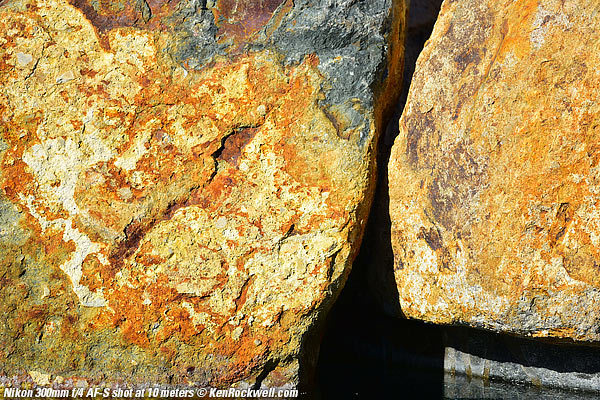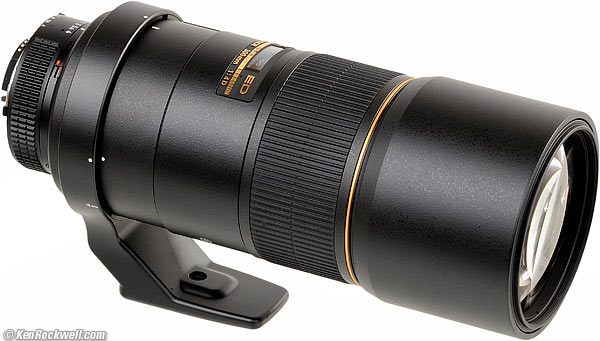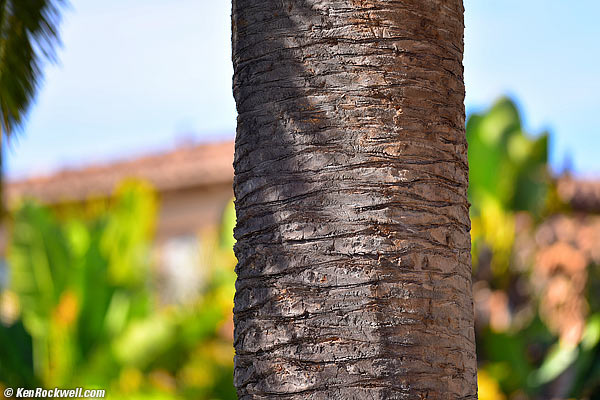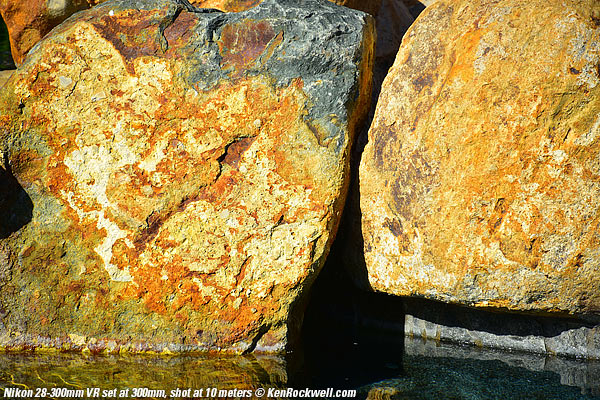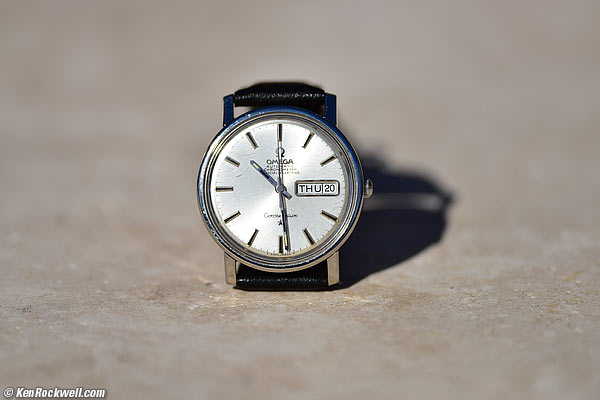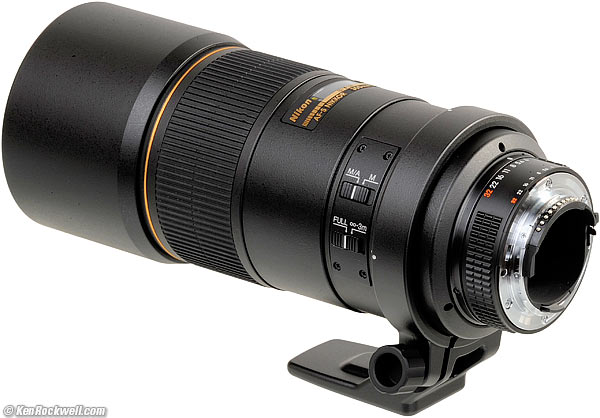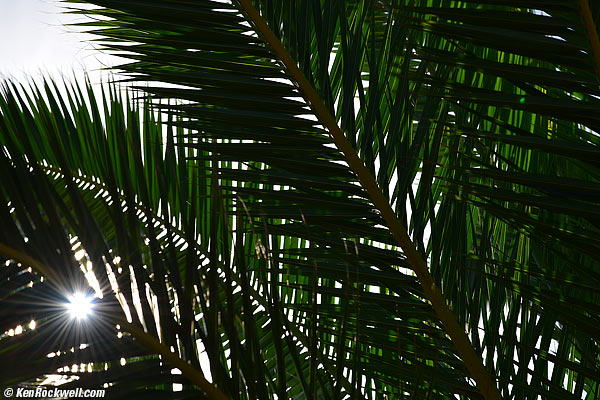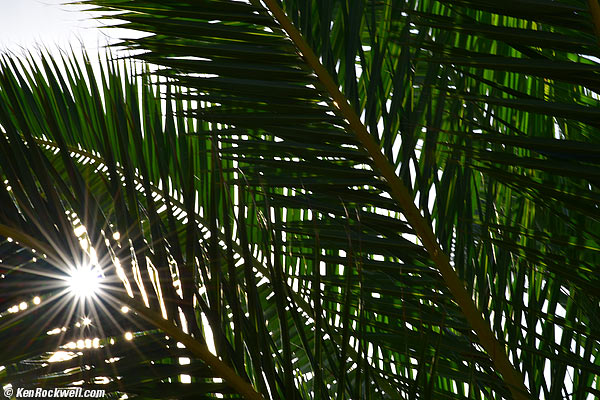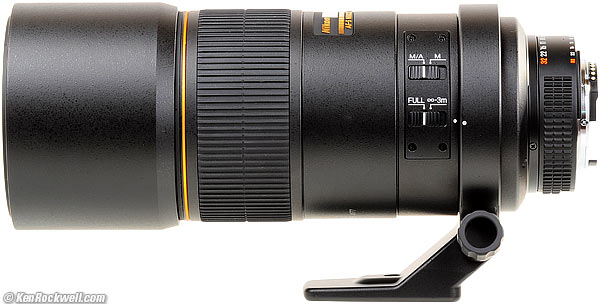Home Donate New Search Gallery Reviews How-To Books Links Workshops About Contact
Nikon 300mm f/4
AF-S NIKKOR
(2000-today)
© 2015 KenRockwell.com. All rights reserved.
Sample Images Intro Specifications Performance
Usage Compared Recommendations More
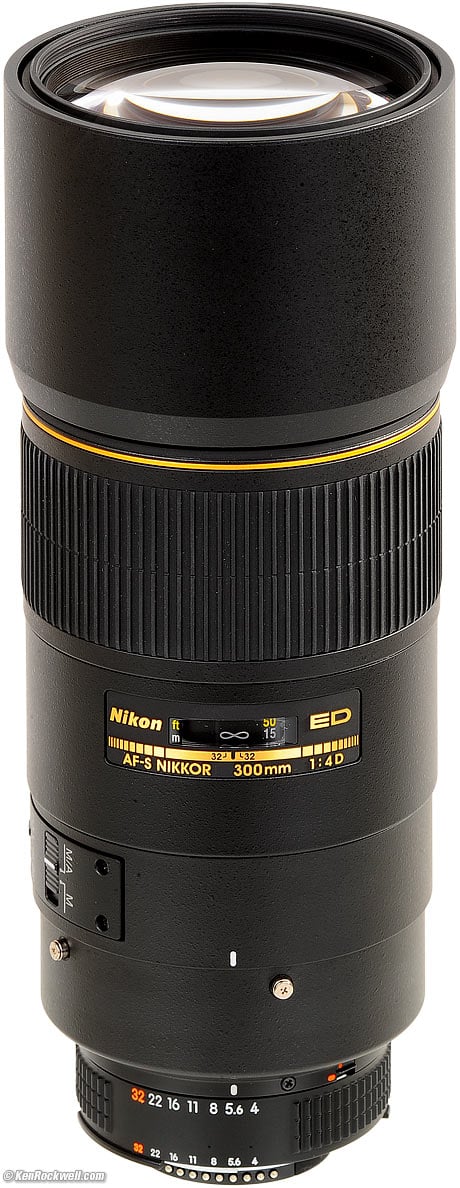
Nikon 300mm f/4 AF-S (FX, DX and 35mm coverage, metal 77mm filter thread, 46.7 oz./1,295g as shown; 50.863 oz. /1,442.0 g with tripod collar, 4.7'/1.45m close focus, about $1,370 new or about $750 used if you know How to Win at eBay).
I got mine at this link directly to this lens at Adorama; Amazon or used at eBay are also good places.
This all-content, junk-free website's biggest source of support is when you use any of these links to approved sources when you get anything, regardless of the country in which you live. Nikon does not seal its boxes, so never buy at retail or any source not on my personally approved list since you'll have no way of knowing if you're getting a defective or damaged customer return or a used lens. Buy only from the approved sources I use myself for the best prices, service, return policies and selection. Thanks for your support! Ken.
January 2015 Nikon Reviews Nikon Lens Reviews All Reviews
Why Fixed Lenses Take Better Pictures
All Nikon 300mm f/4 Lenses Compared
NEW: Nikon 300mm E PF VR. An all new lens that weighs half what this does, and adds VR.
Sample Images (more throughout the review) top
Sample Images Intro Specifications Performance
Usage Compared Recommendations More
Rocks. Shot wide-open at f/4 on full-frame. Full-resolution 36 MP file.
As you can see in the full-resolution image, the 300/4 AF-S is insanely sharp from edge to edge, even wide-open. (remember that the sides and corners probably aren't in focus as the rocks are not flat in this sample.)
Introduction top
Sample Images Intro Specifications Performance
Usage Compared Recommendations More
Compatibility History Production
|
Adorama pays top dollar for your used gear. I use these stores. I can't vouch for ads below.
|
This Nikon 300mm f/4 AF-S is an extremely sharp 300mm lens designed for those who shoot with tripods and demand the sharpest 300mm lens possible. If you count all your pixels, this lens is sharper than any of Nikon's zoom lenses.
This lens is also for those who demand a true 300mm lens whose effective focal length does not shorten at close distances, as it the case with many zooms.
Another outstanding feature of this 300mm f/4 is its super close focussing. Any lens that focuses more closely will be a zoom which cheats and shortens its real focal length to achieve the closer focus.
This tough, mostly metal professional lens is optically fantastic, but it's heavy; it's almost twice as heavy as the 28-300 VR or 70-300mm VR.
The Silent-Wave-Motor autofocus is super-fast, and you may grab the focus ring at any time for instant manual focus override.
It's perfect for use on every FX digital, every DX digital and almost all 35mm cameras.
Everything works perfectly on every digital Nikon ever made, both FX and DX, from the best Df, D4s, D810, D750 and D610 to Nikon's cheapest digitals like the D40, D40x, D60, D3000, D3100, D3200, D3300, D5000, D5100, D5200 and D5300.
It works perfectly on all Nikon 35mm cameras made since 1977.
It's also perfect on decent or recent AF film cameras like the F6, F100, F5, N80 and N75.
The incompatibilities for older or cheaper 35mm cameras are that:
1.) It won't autofocus with the cheapest AF 35mm cameras like the N55, but if you focus manually, everything else works great. Even if you lose autofocus, these cameras have in-finder focus confirmation dots to help you.
2.) You'll have no AF with the oldest AF cameras like the N2020, N6006 and N8008. Manual focus is fine, along with electronic focus indications.
3.) With 35mm cameras from 1976 and before, you'll either need to have a service facility add an aperture-coupling prong to the aperture ring, or use stop-down metering. All 1977 and newer Nikons are Automatic Indexing (AI) and will couple perfectly to this lens' aperture ring, automatically.
See Nikon Lens Compatibility for details with your camera. Read down the "AF-S, AF-I" column for this lens.
1964-1969: 300mm f/4.5 NIKKOR-P
Nikon's first 300mm SLR lens was the f/4 NIKKOR-P.
It had 5 elements (P = Penta = 5) and had very strong lateral color fringing.
1969-1998: 300mm f/4.5 NIKKOR-H to AI-s
Nikon updated the design to six elements in the 300mm f/4.5 NIKKOR-H (H = Hexa = 6).
Coatings vary somewhat by era; multicoating came along in the 1970s.
Nikon made many different mechanical versions of this lens from 1969 through 1998 and they all share the same very good optics.
Its optics are far superior to to previous NIKKOR-P.
1977-1999: 300mm f/4.5 NIKKOR-ED and ED-IF
The 300mm f/4.5 ED (1977 - 1979) and 300mm f/4.5 ED-IF (1978 - 1999) are newer, more expensive and quite different designs.
They weigh less, are a little sharper and focus more closely than the older lenses.
1987-2000: 300mm f/4 AF
The 300mm f/4 AF (1987 - 2000) has even better optics, and adds autofocus.
It is built like a tank, and has slow autofocus speed to match. You have to move two switches to get from auto to manual focus.
2000-present: This lens
This 300mm f/4 AF-S has the best optics yet, and adds ultra fast autofocus with instant manual focus override.
Nikon has made about 50,000 of these lenses since 2000, and still makes them today.
Nikon 300mm f/4 AF-S. enlarge.
Specifications top
Sample Images Intro Specifications Performance
Usage Compared Recommendations More
Name top
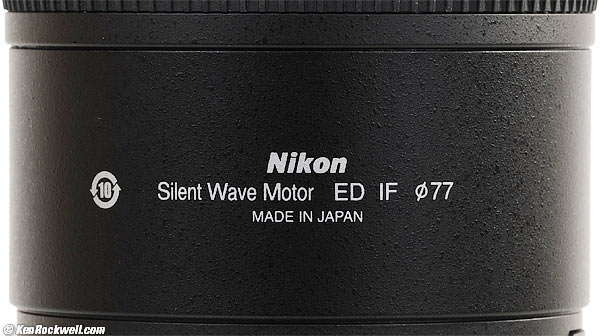
Nikon 300mm f/4 AF-S bottom.
Nikon calls this the Nikon AF-S NIKKOR 300mm f/4 D SWM ED IF ∅77.
AF-S and SWM: Silent Wave Autofocus Motor.
NIKKOR: Nikon's brand name for all their lenses.
D: Couples distance information to the Matrix Meter.
ED: Magic Extra-low Dispersion glass for reduced secondary chromatic aberration.
IF: Internal focusing; nothing moves externally as focused.
∅77: 77mm filter thread.
MADE IN JAPAN: Domestic manufacture reserved for Nikon's finest lenses.
Optics top

Nikon 300mm f/4 AFS internal diagram. ED glass.
10 elements in 6 groups.
2 ED glass elements.
Internal focussing.
It's multicoated, which Nikon calls Nikon Super Integrated Coating.
Close Focus top
4.7 feet (1.45 meters) from the image plane, marked.
Maximum Reproduction Ratio top
1:3.7 (02.7x).
Diaphragm top
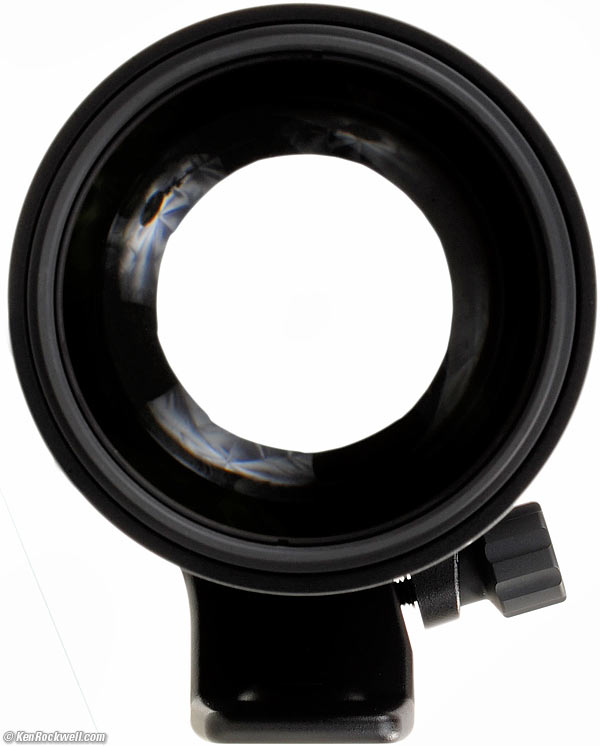
Nikon 300mm f/4 AF-S at f/5.6.
9 rounded blades.
Stops down to f/32.
Coverage top
Focal Length top
300mm.
When used on a DX camera, it sees angles of view similar to what a 450mm lens sees when used on an FX or 35mm camera.
Angle of View top
8.2° on FX digital and 35mm.
5.3° on small-format DX.
Hard Infinity Focus Stop? top
No.
You have to let the AF system focus at infinity.
Focus Scale top
Yes.
Depth-of-Field Scale top
Sort of; only for f/32.
Infra-Red Focus Index top
No.
Aperture Ring top
Yes!
Full-stop clicks.
Tripod Collar top
Included.
Comes off, but you have to pull it off the back of the lens with the camera unattached.
Filter Thread top
77 mm, metal.
Never moves.
Hood top
Built-in Hood Extended, Nikon 300mm f/4 AF-S. enlarge.
Built-in plastic telescoping hood.
Case top
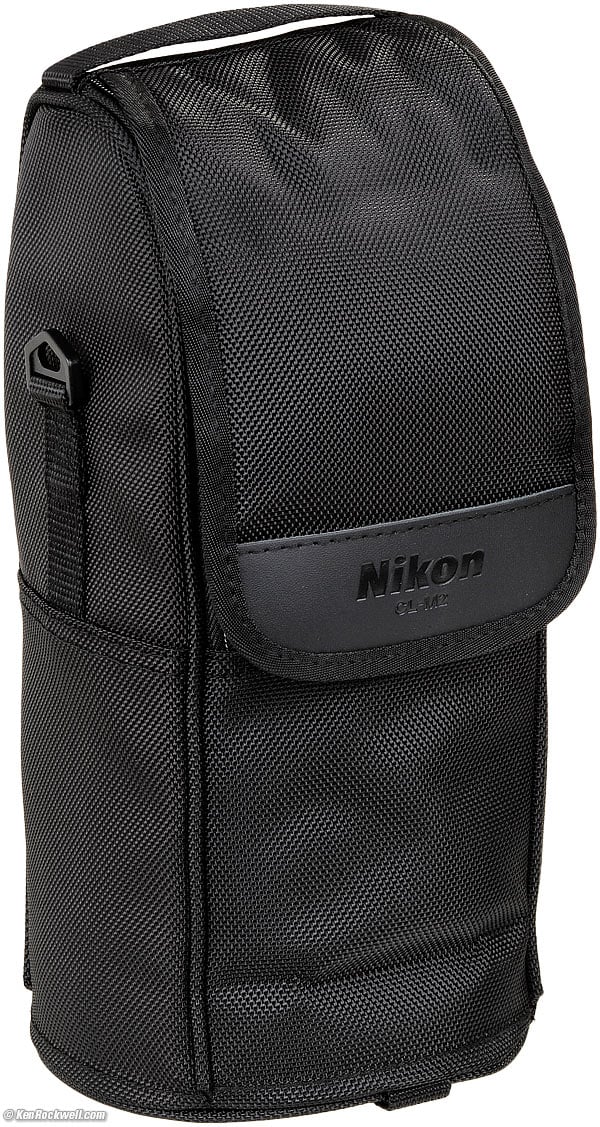
Included CL-M2 Case, Nikon 300mm f/4 AF-S.
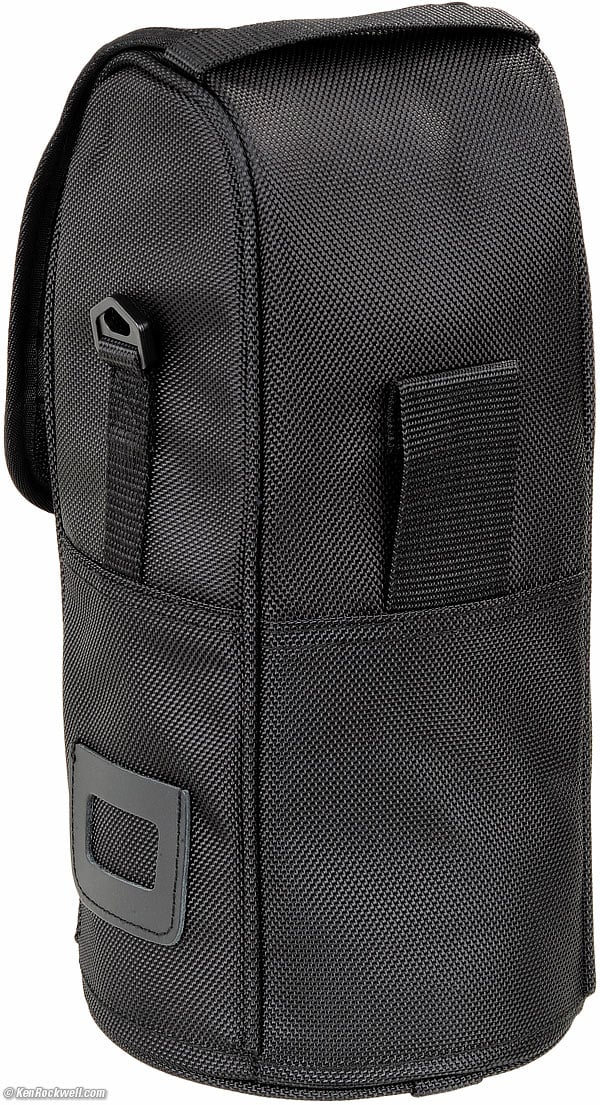
Back of Included CL-M2 Case.
CL-M2 padded nylon case, included.
It's the same case as included with the 80-400mm VR AFS and 70-200/2.8 VR and 70-200/2.8 VR II.
Size top
Nikon specifies 3.5" (90 mm) diameter by 8.8" (222.5 mm) extension from flange.
Weight top
Lens and tripod adapter
50.863 oz. (1,442.0 g) actual measured weight with collar.
Nikon specifies 50.8 oz. (1,440 g).
Lens Only
46.665 oz. (1,294.6 g) actual measured weight, no collar.
Rated 46 oz. (1,300g).
Color top
Black as shown, also white as an option in Japan to mimic Canon.
Included top
Snap-on 77mm front lens cap.
LF-4 rear cap.
CL-M2 case.
Paperwork.
Quality top
Made in Japan.
Warranty top
5 years, USA.
Teleconverters top
TC-300/301 and TC-14B. TC-14E, TC-17E and TC-20E teleconverters are compatible.
The -E teleconverters allow autofocus, but your camera may not work well with the TC-17E or TC-20E because the effective aperture becomes f/6.7 or f/8, respectively.
The TC-300, TC-301 and TC-14B are older manual focus teleconverters.
Packaging top
Gold-tone microcorrugated cardboard box with top and bottom foam to hold the case.
Lens sits inside case.
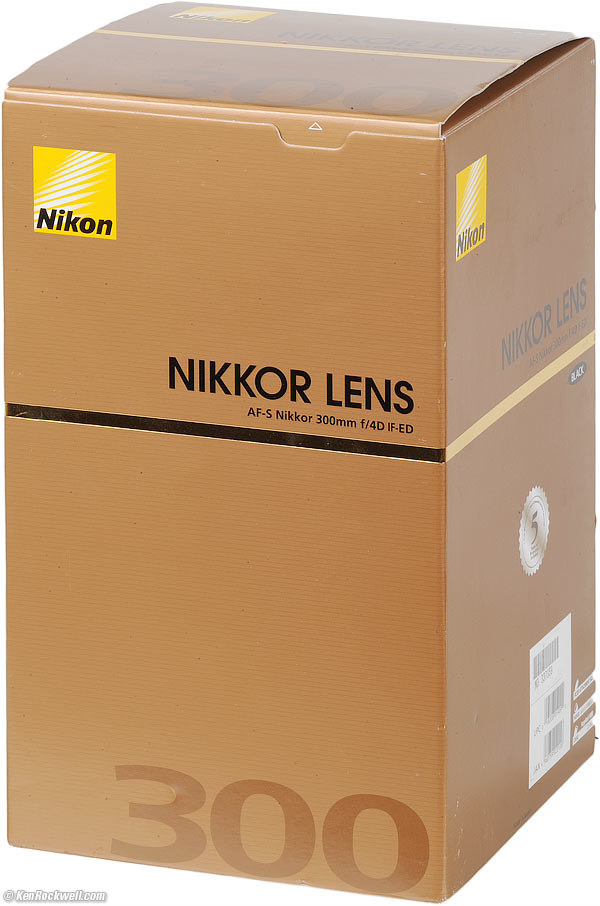
Box, Nikon 300mm f/4 AF-S.
Announced top
2000.
Nikon Product Number top
1909.
Price, USA top
$1,370, November 2014.
$1,200 in 2011.
Performance top
Sample Images Intro Specifications Performance
Usage Compared Recommendations More
Overall Autofocus Bokeh Color Coma
Distortion Ergonomics Eyeblow Falloff Filters
Focal Lengths, effective Focus Breathing Ghosts
Hood Lateral Color Fringes Macro Mechanics
Sharpness Sunstars Teleconverters Tripod Collar
Overall performance top
The Nikon 300mm f/4 AF-S is an ultrasharp, high performance and completely professional lens.
Autofocus performance top
AF Speed
Autofocus is super fast. It's got a big AF-S motor in it, not the little ones found in Nikon's consumer zooms.
AF Accuracy
On my D810, AF was always perfect.
Manual Focus
Manual focus is fine.
Just grab the ring at any time for instant manual override.
Bokeh performance top
Bokeh, the character of out of focus backgrounds, not simply how far out of focus they are, is neutral.
Nikon 300mm f/4 AF-S at 30 feet (10 meters) at f/4. Full-resolution. Also note how super-sharp is the tree (the bottom is closer to the upwards-pointed camera and not in focus.)
Used close enough for a head shot, there will be much less in focus in the background.
When used close as you can see at Macro, depth of field is about zero and backgrounds simply disappear.
Color Rendition performance top
The color rendition is the same as my other Nikkor AF lenses.
Coma performance top
Coma (saggital coma flare) often causes weird smeared blobs to appear around bright points of light in the corners of fast or wide lenses at large apertures. In lenses that have it, coma goes away as stopped down.
I see no coma in this lens.
Distortion performance top
The Nikon 300mm f/4 AF-S has no visible distortion.
For more critical photogrammetric use, it does have a tiny bit of pincushion distortion, which easily is corrected with these values in Photoshop's lens distortion filter. These aren't facts or specifications, they are the results of my research that requires hours of photography and calculations on the resulting data
120' (35m) |
-0.7 |
30' (10m) |
-0.7 |
10' (3m) |
-1.0 |
4.7 (1.45m) |
-1.0 |
© 2014 KenRockwell.com. All rights reserved.
Recent digital cameras like the D90, D3100, D3200, D3300, D5000, D5100, D5200, D5300, D7000, D7100, D4, D4s, D600, D610, D750, D800, D800E, D810 and Df can be set to correct the distortion automatically in-camera. This lens is so good that I didn't bother trying it.
Ergonomics (handling and ease-of-use) performance top
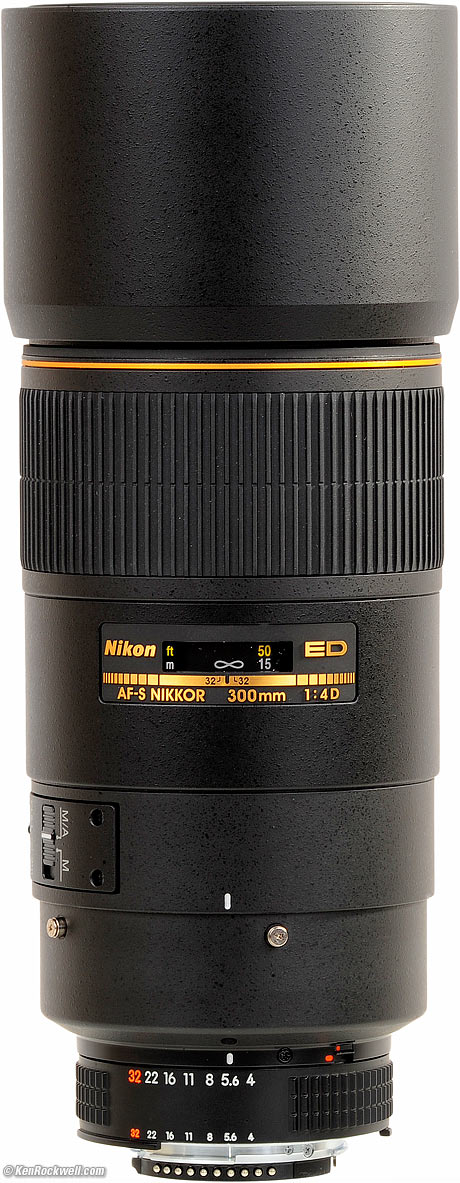
Nikon 300mm f/4 AF-S.
Ergonomics are easy. Just grab the ring for manual focus.
It's a moderately big and heavy lens, and its few controls are easy to use.
Eyeblow performance top
No air pumps in or out of the back of the 300/4 AFS as it's focused.
Falloff (darkened corners) performance top
Falloff on FX and 35mm is minor at f/4, and invisible otherwise.
It won't be an issue at all on DX (see crop factor), or if you engage vignetting correction in your menus.
I've exaggerated this by shooting a gray field and placing these on a gray background.
Nikon 300mm f/4 AF-S falloff on FX and 35mm at infinity, no correction.
© 2014 KenRockwell.com. All rights reserved.
|
Filters, use with performance top
Typical for long telephoto lenses, there is no problem with vignetting, even with combinations of thick filters.
Focal Length, effective performance top
The effective focal length of the 300/4 stays the same as focussed more closely.
The 300mm end of the 70-300mm VR is an honest 300mm at all distances, but the 300mm end of the 28-300mmm VR gets shorter at closer distances.
It does not shorten at closer distances as seen in many zooms like the 28-300mm VR. Here are two shots made from the same position with each of these lenses:
Rocks. Shot wide-open at f/4 on full-frame. Full-resolution 36 MP file.
Rocks. Shot on 28-300mm VR at 300mm from same location.
These are both from 10 meters (30 feet). While both lenses see the same thing at infinity, the 28-300mm isn't really 300mm at 30 feet, and the relative difference increases as we get closer. The maximum effective focal length of the 28-300 is only 150mm at 4.5 feet, while this 300/4 stays at a real 300mm.
This mean you can get much closer shots from the same distance with this lens than with many zooms.
Focus Breathing performance top
Of interest mostly to cinematographers focusing back and forth between two subjects, the image from the Nikon 300mm f/4 AF-S gets larger as focused more closely.
Ghosts performance top
I see no ghosts when pointed into the sun.
The worst I could deliberately cause was a violet blob like this:
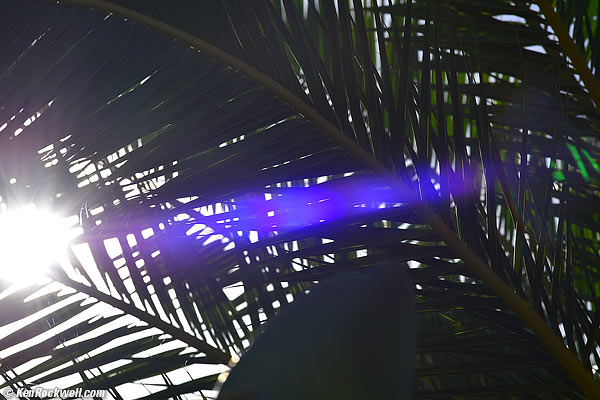
Nikon 300/4 AFS flare at f/11.
This was the absolute worst I could conjure; I never saw any of this in actual shooting.
Hood performance top
The hood is better than most built-ins because it locks in the extended portion with a quarter-twist. It doesn't keep working its way back in as most pull-out hoods that don't lock do.
Lateral Color Fringes performance top
There are no lateral color fringes on the D810, which corrects whatever there may be automatically.
This is superb performance!
Macro performance top
Macro gets super close, and is super sharp, even wide-open at f/4.
Omega Constellation on full-frame at close-focus distance at f/4.

Crop from above 36 MP image at 100%. If this is 6" wide on your screen, the complete image printed at this same magnification would be 75 x 50." (6 x 4 feet, or 2 x 1.25 meters!)
Not all of this is sharp became not all of it is in focus. Depth of field here is only fraction of a millimeter.
Mechanics and Construction performance top
Nikon 300mm f/4 AF-S. enlarge.
The Nikon 300mm f/4 AF-S is built to professional standards. It's not a plastic zoom like most of Nikon's lenses today.
Filter Threads
Metal.
Hood
Tough plastic built-in locking hood.
Thin black fuzz on inside.
Rubber bumper on barrel when collapsed.
Front Barrel
Metal.
Focus Ring
Metal; rubber covered.
Mid Barrel (around focus window)
Plastic.
Rear Barrel (near tripod collar)
Metal.
Focus Helicoids
Feel like metal .
Focus Scale
Yes.
Depth of Field Scale
Only for f/32.
Internals
Metal.
Aperture Ring
Plastic.
Engraved numbers filled with paint.
Mount
Dull-chromed brass.
Identity Plate
Debossed metal, 18k gold filled.
Serial Number
Laser engraved onto bottom rear of aperture ring.
US Model Signified by
Nikon USA paperwork in box.
"5 Years" warranty sticker on outside of box.
There is no "US" in the serial number.
Dust seal at mount
No.
Noises When Shaken
Only very soft clicking.
This is a very solid lens.
Made in
Japan.
Sharpness performance top
Warning 1: Image sharpness depends more on you than your lens.
Warning 2: Lens sharpness doesn't mean much to good photographers.
While amateurs waste time worrying about lens sharpness, pros know that lens sharpness has little to do with making sharp pictures. This said, the Nikon 300mm f/4 AF-S is, like Nikon's other fixed super telephotos, among their sharpest lenses.
Presuming you're in perfect focus and you're not doing anything wrong, this 300 f/4 is fantastically sharp from edge to edge on full frame, even wide-open at f/4.
Besides the usual things people do wrong, the on;y limitation to sharpness will be if you stop down more than needed, in which case diffraction limits your performance.
Here are Nikon's MTF curves, which agree with what I see: flawless sharpness from edge to edge:

Sunstars performance top
With its rounded diaphragm, the 300/4 makes few sunstars.
Blah sunstar at f/11.
TO get sunstars, you need to stop down to around f/32 to get 18-pointed sunstars on brilliant points of light:
Sunstar at f/32.
Teleconverters, Use with performance top
Since it's only f/4, a TC-14E is your only safe option.
The TC-17E and TC-20E create effective apertures too small for great autofocus performance. I tried it with my TC-20E on my D810, and autofocus usually got lost. If you focused the lens manually to about the right distance, AF would drive it the rest of the way home, but don't expect AF to work all by itself.
I also tried it with an old manual focus TC-14B, with which it worked fine — in manual focus of course.
Tripod Collar performance top
The collar comes off, but you have to slide it off the back of the lens with the camera removed.
When removed, there are still little metal nubbins on the back of the lens that aren't exactly comfortable for long-term use.
Usage top
Sample Images Intro Specifications Performance
Usage Compared Recommendations More
Aperture Ring
Unless you're using this on a manual-focus 35mm camera, you must set the aperture ring to f/32, marked in orange.
If you don't, you'll see a blinking "Fee" warning in your finder until you set it to f/32.
There's a lock on the aperture ring, use it.
Nikon 300mm f/4 AF-S switches. bigger.
M/A - M Switch
Nikon goofed. This switch is supposed to be labeled "A - M."
The "M/A" position means autofocus. It's called "M/A" because you also can focus manually simply by grabbing the focus ring in this position.
The "M/A" position means autofocus. It's called "M/A" because back in the old days, when Nikon had almost caught up to Canon who had been doing this for ten years before, Nikon was trying to show off that you could focus manually while in the AF position.
Paint over the extra M if you're easily confused.
FULL — ∞-3m Switch
This is the focus limiter.
Leave it in FULL, unless your subjects are more than 3m (10 feet) away and the lens keeps getting lost and "hunting" for your subject. If so, the ∞-3m setting prevents AF from trying to focus closer than 3 meters, and will speed up the autofocus if your camera keeps trying to focus too closely looking for your subjects.
Compared top
Sample Images Intro Specifications Performance
Usage Compared Recommendations More
This 300mm f/4 AFS is significantly sharper than the 70-300 VR and 28-300mm VR lenses at 300mm, if and only if you're looking at the results from a high-resolution camera at 100% on your screen.
This lens also weighs almost as much as those two lenses put together, and this lens has no VR so using a tripod is often a good idea.
This mostly metal lens makes the others feel like plastic toys.
For actual use at reasonable print sizes, the zooms are more than sharp enough.
Recommendations top
Sample Images Intro Specifications Performance
Usage Compared Recommendations More
This Nikon 300mm f/4 AF-S is for the photographer who shoots on a tripod. It's the perfect 300mm lens for the sorts of people who love to shoot raw and demand the absolute highest technical image quality.
It certainly will be sharper than a 70-200mm VR II and TC-14E.
Personally I prefer to travel light, and shoot the 28-300mm VR instead. While not as sharp under idea conditions, personally I don't feel like carrying this heavy fixed 300mm lens with me out in the woods. I get farther and get more photos with my light plastic 28-300 and no tripod than I ever would toting this fixed lens and a tripod.
On the other hand, if you're a tripod kind of guy, by all means this is your lens. It's as sharp as the 300mm f/2.8 VR II, and a lot less expensive and a lot lighter, too. This 300mm lens' optics are flawless, which if you split pixels, you will see slight defects with the zooms I prefer to carry.
When you get yours, use only these links to approved sources of supply, especially this link directly to this lens at Adorama, at Amazon or used at eBay. Using any of these links when you get anything, regardless of the country in which you live is my biggest source of support and ensures you get the best prices, selection and service. It helps me keep reviewing these lenses when you get yours through these links — but I receive nothing for my efforts if you take your chances and buy elsewhere. Never buy at retail; Nikon doesn't seal its boxes so you never can be sure if you really got a new lens or not when buying at retail.
Thanks for your support!
Ken.
Deployment
I'd leave either a 77mm Nikon Clear (NC - UV) filter, or a 77mm Hoya Alpha MC UV on the lens at all times.
If you want the best possible protective filter, the 77mm Hoya HD2 Protector is ultra multicoated, repels dirt and fingerprints and made of shatter resistant glass.
If I was working in nasty, dirty areas and don't want to spring for the HD2 filter, I'd use an uncoated 77mm Tiffen UV filter instead. Uncoated filters are much easier to clean, but more prone to ghosting.
I would leave the hood at home.
For color slides like Velvia 50, I use a 77mm Hoya HMC 81A or 77mm Nikon A2 filter outdoors.
For B&W film outdoors, I'd use a 77mm Hoya HMC Yellow K2 or 77mm Hoya HMC Orange.
More Information top
Sample Images Intro Specifications Performance
Usage Compared Recommendations More
Nikon's page on the 300/4 AFS.
Help me help you top
I support my growing family through this website, as crazy as it might seem.
The biggest help is when you use any of these links when you get anything, regardless of the country in which you live. It costs you nothing, and is this site's, and thus my family's, biggest source of support. These places have the best prices and service, which is why I've used them since before this website existed. I recommend them all personally.
If you find this page as helpful as a book you might have had to buy or a workshop you may have had to take, feel free to help me continue helping everyone.
If you've gotten your gear through one of my links or helped otherwise, you're family. It's great people like you who allow me to keep adding to this site full-time. Thanks!
If you haven't helped yet, please do, and consider helping me with a gift of $5.00.
As this page is copyrighted and formally registered, it is unlawful to make copies, especially in the form of printouts for personal use. If you wish to make a printout for personal use, you are granted one-time permission only if you PayPal me $5.00 per printout or part thereof. Thank you!
Thanks for reading!
Mr. & Mrs. Ken Rockwell, Ryan and Katie.
Home Donate New Search Gallery Reviews How-To Books Links Workshops About Contact

